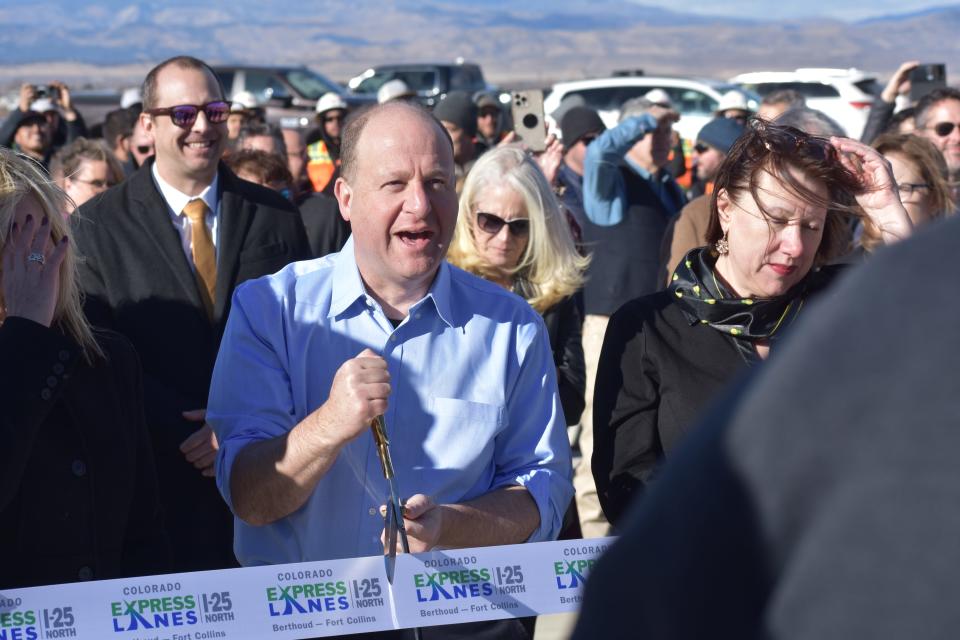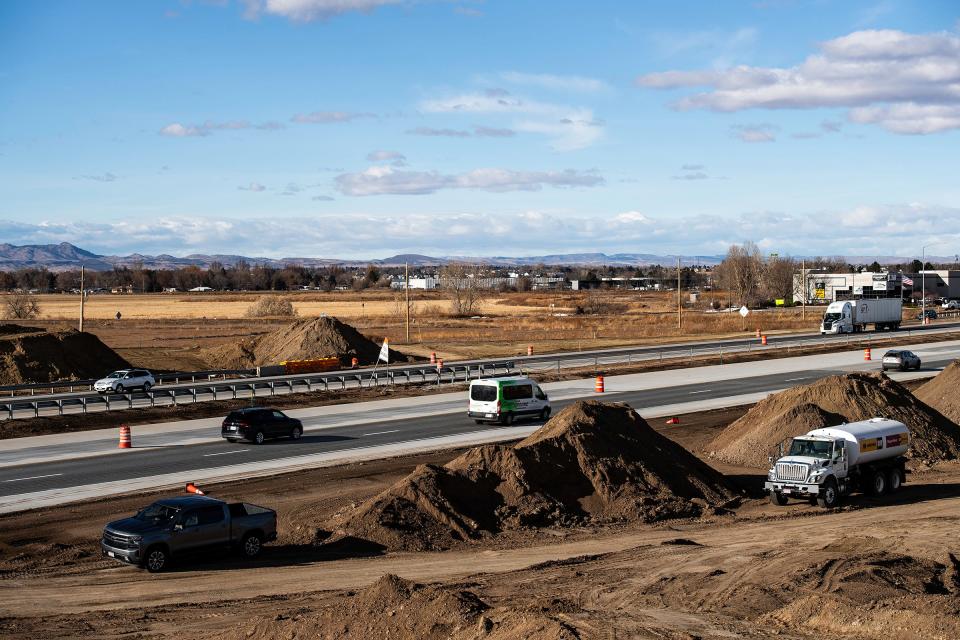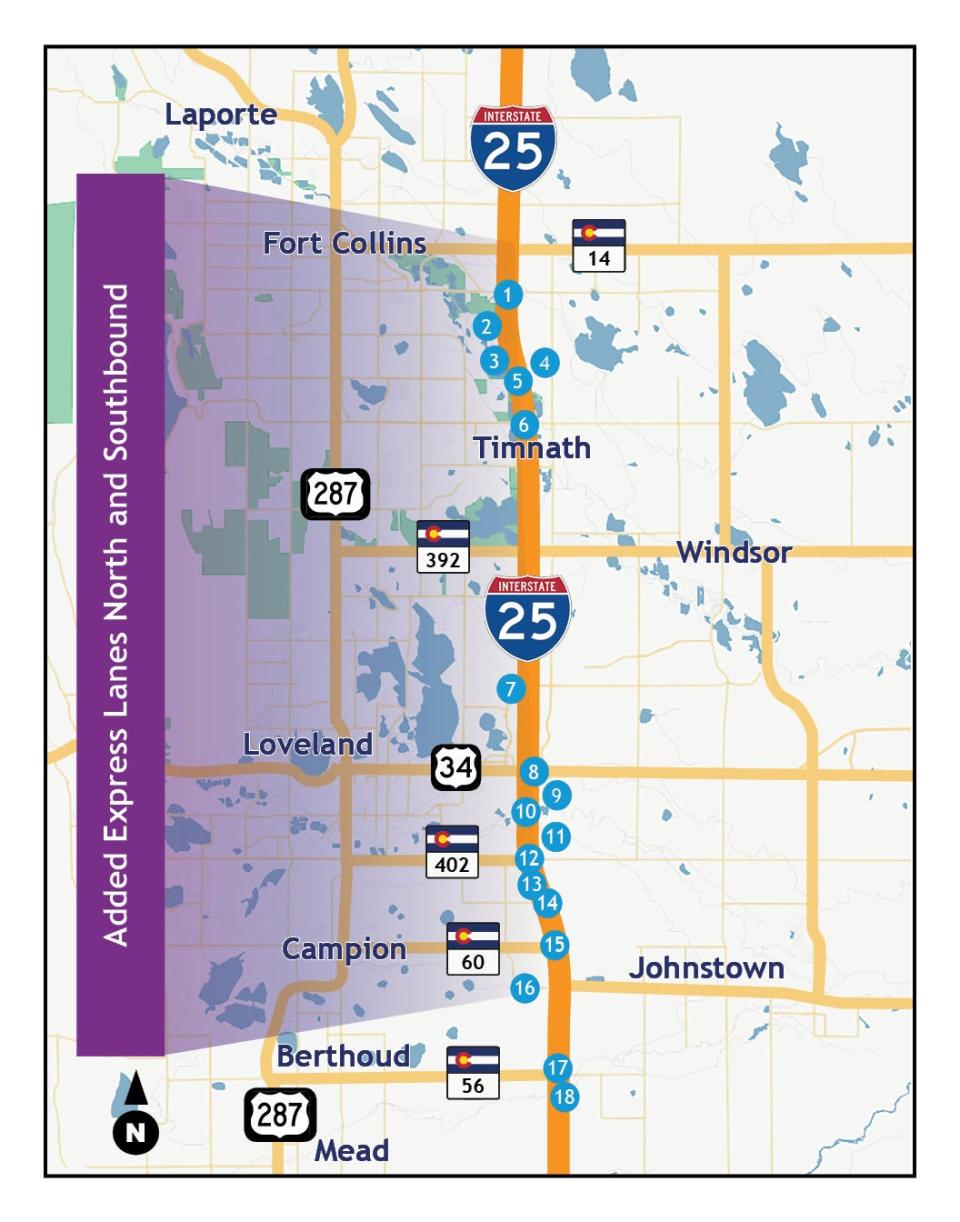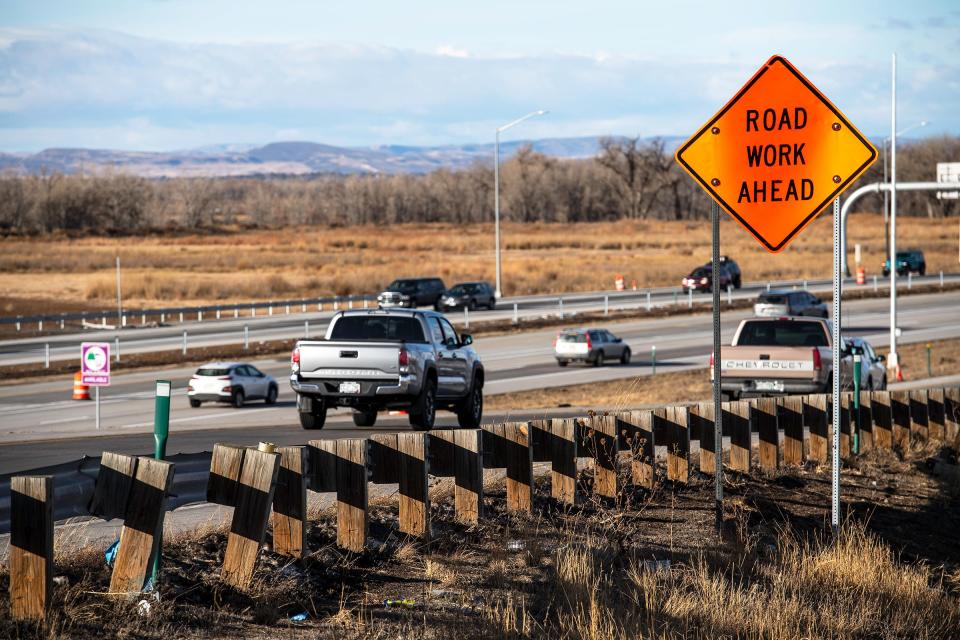North I-25 Express Lanes now open: How your commute is expected to improve
Editor's note: This story originally published Dec. 7 and has been updated following the Dec. 15 opening of the project's lanes.
Former Gov. John Hickenlooper shoveled the first dirt of the North I-25 Express Lanes project five years ago.
On Thursday, Dec. 7, Gov. Jared Polis and other dignitaries cut the ceremonial ribbon signaling the substantial completion of the $900 million project.
At the ceremony in the parking lot of the project's Loveland bus slip, officials announced the project's lanes — a new express lane and two general purpose lanes in each direction — would open for travel Dec. 15.
Several people at the ceremony repeatedly used one word to sum it up: "Finally."
There has been much grumbling about the length of time to open the 19-mile-long project on Interstate 25 from Berthoud to Fort Collins, but Colorado Department of Transportation officials are as happy as drivers that the wait is over.
"It's like a kitchen or bathroom remodel," said Abra Geissler, CDOT's manager of the project. "It's not fun when going through it, but when it's done it always seems to be worth it."
Work will continue into 2024 on other aspects of the project, but lane closures will be minimal, officials said.
Here's a look at the project and how it is intended to improve travel time and safety in Northern Colorado.

North I-25 Express Lanes project among largest CDOT projects
Geissler said the project — including design, right-of-way purchase, relocating utilities and construction — will cost around $900 million.
That's second only to the $1.2 billion central Interstate 70 project through Denver that was completed in 2022.
That project included reconstruction of a 10-mile stretch of I-70 between Brighton Boulevard and Chambers Road, including an express, or toll, lane and removing a 57-year-old viaduct.
Here are highlights of the upgrades included in the North I-25 Express Lanes project
This project took into consideration future needs by including enough room to add a fourth lane in each direction.
The expected lifespan of the project is 35 years for the concrete travel lanes and 75 years for the bridges/overpasses.
Project highlights include:
35 bridges, including one each for northbound and southbound I-25 lanes plus single bridges on east-west roads that intersect I-25.
5 complete interchange reconstructions.
2 mobility hubs at Loveland and Berthoud.
Express lane in both directions.
Widened travel lanes. When I-25 was completed in 1963, the two travel lanes and shoulder were 38 feet wide in one direction. The new interstate will be 64 feet wide in each direction.
How will the North I-25 Express Lanes project improve travel times?
This busy stretch of I-25 averages 86,000 vehicles daily, according to CDOT.
Geissler said CDOT doesn't have an exact number to indicate travel time saved but said similar projects that included express lanes such as on U.S. Highway 36 between Denver and Boulder haves shown travel time improvements and reliability.
"Congestion varies, so at night there won't be a lot of time savings but going through the corridor during the day you will see that timesaving," she said.

CDOT studies have shown 14% and greater improvement in travel times on some of its express lanes. Express lanes remove some of the traffic from the free, or general purpose, lanes to improve drive times and create more consistent travel times.
Past CDOT estimates indicate conservatively that 15% of all personal vehicles use express lanes, with most of that use coming during peak travel time.
The project also will improve freight times and reliability on Colorado's only major north-south trucking route.
Mobility hubs, expected to be operational in spring 2024, will reduce traffic. Using Bustang from those hubs in the middle of I-25 is expected to reliably save at least 10 to 15 minutes of travel time from Loveland to Denver.

How will the North I-25 Express Lanes project improve safety?
This corridor was among the state's most dangerous highways prior to the project, with sections having a fatality rate 26% higher than the fatality rate for all Colorado interstates, according to a CDOT report.
The number of crashes increased during construction compared to before it, but Geissler said an array of safety measures were incorporated into the new design to reduce crashes.
Those include:
An express lane in each direction to reduce congestion and stop-and-go traffic, which leads to rear-end collisions, the most frequent crash type in the corridor.
Straightened curves and realigned lanes of 20 lane miles to improve sight lines.
Widened shoulders from 4 feet to 10-12 feet to increase safety for first responders.
Lengthened acceleration and deceleration lanes to improve merging safety and lengthened off-ramps to reduce backups onto the interstate.
Adding anti-weaving technology in the 4-foot divider between the express and general purpose lane to avoid merging crashes.
Adding cable rail between northbound and southbound lanes, which reduces head-on collisions.
Geissler said the most dangerous intersection of I-25 north of Denver was at Colorado Highway 56.
She said the project straightened I-25, flipped it from going under Colorado 56 to over it and made straighter and wider lanes to alleviate the prior pinch point of tight bridges on the former curve.
"We looked at crash data and came up with a safety assessment that allowed us to put more resources into addressing issues in those hot spots to reduce crashes," Geissler said.
Other crash hot spots where safety concerns were addressed include Colorado Highway 402, U.S. Highway 34 and Colorado Highway 60.
When will tolling start on the North Express Lanes, and how much will it cost?
Toll testing and installation is expected to continue until at least the middle of 2024.
Until tolling goes live, drivers will be able to use the express lanes for free.
Toll fees have not yet been determined but likely will mirror existing variable toll fees on I-25. Most express lanes in Colorado charge $2 to $5, with the price lower with less congestion and higher with more congestion. The same transponders as currently employed are expected to be used.
The express lane is free for those vehicles with a driver and at least two passengers with an ExpressToll pass.
Why was a toll lane added and not a general purpose lane?
A toll lane was always part of the project design.
Revenue from the toll lane — along with financial help from federal, state, municipal, county and private business sources — allowed the project to be bundled into one big project instead of completed in smaller sections. That resulted in project completion 14 years ahead of schedule.
Toll fees are being used to help repay financing of the project's loan.

Why did the North I-25 Express Lanes project not include the Mulberry Street/Colorado Highway 14 interchange?
The north end of the project stops just past the Prospect Road interchange and short of the Mulberry Street/Colorado Highway 14 interchange.
The Mulberry Street/Colorado 14 interchange was originally part of the North I-25 Express Lanes project but was removed due to funding prioritization, among other considerations, including that the bridge deck was renovated around 2017, extending the life of the bridge over I-25.
Also, traffic volumes drop significantly past Prospect Road, according to CDOT.
CDOT is conducting a study on ways to improve the Mulberry Street/Colorado 14 interchange, but currently there is no funding for the project.
What is left to do on I-25 between Fort Collins and Denver?
Work on the last remaining stretch between Fort Collins and Denver that isn't three lanes in each direction will start this spring.
That section is from Berthoud (Colorado 56) to Mead (Colorado Highway 66). It will mirror the section from Berthoud to Fort Collins with two general purpose lanes and one toll lane in each direction.
The $400 million to $450 million project is expected to be completed in three years, which is eight years ahead of schedule.
Once completed, I-25 will include three travel lanes in each direction from Fort Collins to Denver.
North I-25 Express Lanes timeline
Sept. 10, 2018: Then-Gov. John Hickenlooper leads groundbreaking on the project.
October 2018: Construction of the project begins.
2019: Project receives additional funding to include rebuilding the U.S. Highway 34 and I-25 interchange, rebuilding the Kechter Road bridge and extending the project to the segment between Colorado Highway 402 and Colorado 56 (Berthoud Exit). This extends the project deadline by a couple years.
December 15, 2023: All three lanes in each direction will open and majority of project is expected to be completed.
2024: Tolling on express lanes expected to begin the second half of the year.
This article originally appeared on Fort Collins Coloradoan: North I-25 Express Lanes from Berthoud to Fort Collins now open

